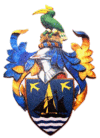Sandakan
| Sandakan | |||
|---|---|---|---|
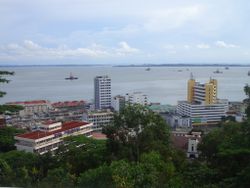 |
|||
|
|||
| Nickname(s): The City of Nature, Little Hong Kong, Elopura | |||
|
|
|||
| Country | Malaysia | ||
| State | Sabah | ||
| Establishment | |||
| Government | |||
| - Council President | Encik Ir. James Wong | ||
| Area | |||
| - Total | 2,266 km2 (875 sq mi) | ||
| Population (2009) | |||
| - Total | 479,121 | ||
| - Density | 184/km2 (488/sq mi) | ||
| Time zone | MST (UTC+8) | ||
| - Summer (DST) | Not observed (UTC) | ||
| Postcode | 90000 to 90999 | ||
| Area code(s) | 089 | ||
| Website | http://www.mps.sabah.gov.my/ | ||
Sandakan is the second-largest city in Sabah, East Malaysia, on the north-eastern coast of Borneo. It is located on the east coast of the island and it is the administrative centre of Sandakan Division and was the former capital of British North Borneo. Sandakan is known as the gateway for ecotourism destinations in Sabah, such as the Sepilok Orang Utan Rehabilitation Centre, the Rainforest Discovery Centre, Turtle Islands Park, Kinabatangan River and Gomantong Caves.
The area is also infamous as the site of a World War II Japanese airfield, built by the forced labour of 6,000 Javanese civilians and Allied prisoners of war. In 1945, the surviving Australian prisoners were sent on the Sandakan Death Marches; only 6 of them survived the war.
Contents |
History
During the early 1870s, the east coast of Sabah was under control of the Sultan of Sulu, who also ruled what is now the southern Philippines. The first European settlement in the area was founded by William Clarke Cowie, a Scottish gun smuggler from Glasgow, who received permission from the Sultan to establish a small trading base. Cowie called his settlement Sandakan, which in (Sulu) language means "the place that was pawned", but it soon came to be known as "Kampung German" after the large number of Germans who also set up posts there. The settlement was part of the lease Austro-Hungarian consul Baron von Overbeck acquired from the Sultan of Sulu in 1878. After the lease was purchased by von Overbeck's British partner Alfred Dent, Kampong German was accidentally razed to the ground on 15 June 1879. The new British Resident, William Burges Pryer, decided not to rebuild the village but to move to (what is now called) Buli Sim Sim on 21 June 1879[1]. He named his new settlement Elopura, which means Beautiful City. A few years later, the name reverted back to Sandakan. The name Elopura still refers to a Sabah state constituency in Sandakan.
In 1883, the capital of the British North Borneo Company was moved from Kudat to Sandakan. In the mid-1930s, Sandakan's timber export reached the record figure of 180,000 cubic meters, making it the largest timber-exporting port of tropical hardwood in the world. At the height of the timber boom, Sandakan boasted that it had the highest concentration of millionaires anywhere on Earth.
The Japanese occupation of Sandakan during World War II began on 19 January 1942 and lasted until a brigade of the Australian 9th Division liberated it on 19 October 1945. The Japanese administration restored the name Elopura for the town. One of the atrocities of World War II was the Sandakan Death Marches, when Japanese soldiers decided to move about 2,400 prisoners of war in Sandakan 260 km (160 miles) inland to the town of Ranau. The prisoners who did not die en route to Ranau were crammed into unsanitary huts; most of those survivors either died from dysentery or were killed by prison guards. When the war ended, Sandakan was totally destroyed, partly from the Allied bombings and partly by the Japanese. As a result, when North Borneo became a British Crown Colony in 1946, the capital was shifted to Jesselton, now known as Kota Kinabalu, (often just called 'KK' locally).
Sandakan remains Sabah's second most important port, after Kota Kinabalu. The port is important for palm oil, tobacco, cocoa, coffee, manila hemp and sago exports. Sandakan is also one of the most bustling towns in East Malaysia. The once dominant timber industry is now relatively small. It is likely tourism will become increasingly important to the town's future.
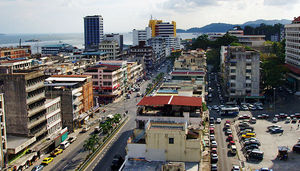
In recent years, businesses have shifted their operations away from the town centre to the suburbs (Bandar Ramai-Ramai, Bandar Leila, Bandar Nam Tung, Bandar Maju, Bandar Kim Fung, Bandar Pasaraya, Bandar Letat, Bandar Indah Jaya, Bandar Utama, Bandar Perdana, Bandar Labuk Jaya, Bandar Sibuga Jaya, etc.) due to the presence of significant illegal immigrants in the town centre. In January 2003, the Sandakan Harbour Square, an urban renewal project, was launched in an attempt to revive the town centre as the commercial hub in Sandakan. It will feature extra shoplots, a new central market and fish market, a shopping mall (Sandakan Harbour Mall), and hotels. It is to be built in three separate phases and is due for completion in this year.
Schools & Academic Institutions
Primary Schools
SK Kg Suan Lamba
SK Abai |
SK Langkabong |
SK Pulau Sanghai |
SK Sungai Padas |
SJK (C) Cheng Ming |
Secondary Schools
|
SMK Agama Sandakan |
SM Teknik Sandakan - Link 1 |
Tertiary Academic Institution
Open University Malaysia, PPT Sandakan (Universiti Terbuka Malaysia) - [1]
Universiti Putra Malaysia - IDEAL Sandakan - [2]
ILP Sandakan (Industrial Training Institute)
Kinabalu College - Link 1
Maktab Rendah Sains MARA Sandakan
Pusat Giat Mara Sandakan
Universiti Malaysia Sabah, Kampus Sandakan
Future & Ongoing developments
- Sandakan Education Hub - a 1,200 acres (4.9 km2) site to be developed as an educational hub for five colleges that have expressed interest to establish campuses in Jalan Sungai Batang, Mile 10, Sandakan.
- Sandakan Harbour Square - consists of 129 unit of shopoffices, a new central market, a Town Square, a shopping centre, hotels and a convention centre.
- Sawit POIC (Palm Oil Industrial Cluster) - a new integrated palm oil industrial hub with 2,800 acres (11 km2) of land earmarked to cluster and centralised all palm oil related industries in one single complex.
- Universiti Malaysia Sabah (UMS) branch campus
- Sandakan Integrated Trade Exchange Terminal (SITExT) - a place for traders to conduct their activities with utmost ease and leisure. " A Sanctuary for Traders". The terminal will be developed on a 33.55 acres (135,800 m2) piece of land in Batu Sapi, Sandakan with custom checkpoint, jetty, warehouse, cold storage, grain terminal, container storage, CIQS (custom, immigration, quarantine and security complex), duty free complex, shop lots, hotel and main office. The Integrated Barter Trade Terminal will undoubtedly become a SANCTUARY that will manage and generate an intrinsic income stream to Sabah's economy. Link to SITExT's Official Website
Sports
Rugby is popular in Sandakan, Eddie Butler, a former Welsh Rugby Union captain, described it as the "Limerick of the tropics"[2] In 2008 at the newly build Sandakan Rugby Club, the Borneo Eagles-Sabahns (a team which included a few professional Fijians), hosted at the Borneo 10-a-side tournament for the eight and last time. Next year the tournament will change to seven-aside, which is an internationally popular format and one which the IRB is promoting as a possible Olympic sport.[2]
Football also popular among the Sandakan folk. A football stadium located in Sibuga Sports Complex can accommodate more that 5,000 persons in one time.
Sights
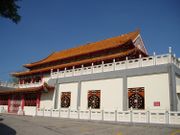
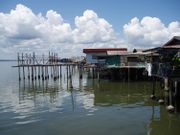
As Sandakan was almost totally destroyed in World War II, there are few surviving buildings of any age. Some of the main sights today include:
- Agnes Keith House, also known as Newlands - two-storey home of local author Agnes Newton Keith and her husband Harry Keith (Conservator of Forests and Curator of the North Borneo Museum). The Keiths lived on this site from 1930 to 1952: they rebuilt the present house on the foundations of their pre-war home which had been destroyed in World War II. Mrs. Keith wrote several books about Sabah and its people, including Land Below the Wind, Three Came Home, and White Man Returns, and a novel, Beloved Exiles.
- Sandakan Memorial Park - built on site of the Taman Rimba, Mile 7 prisoner-of-war (POW) camp.
- Japanese Cemetery - housing a memorial to the Japanese war dead on Borneo.
- Parish of St Michael and All Angels - this beautiful granite church was built in 1897 and was one of Sandakan's few surviving pre-war buildings. It was recognized as one of the world's heritage since year 2005.
- Puu Jih Shih Buddhist Temple - completed in 1987, this fiery red and gold temple overlooks the town centre.
- Sam Sing Kung Temple - completed in 1887, it is the oldest building in Sandakan.
- Sandakan Mosque - completed in 1988, it lies next to the bay and Kampung Buli Sim Sim.
- Kampung Buli Sim Sim - stilt fishing village on the original site of Sandakan town.
- Sandakan Market - one of the largest and busiest in Sabah.
- Crocodile Farm - located 12 km (7.5 miles) out of town, it houses more than 2,000 of the reptiles in concrete pools.
- Labuk Bay Proboscis Monkey Sanctuary - a perfect Proboscis Monkey observation spot for tourists who wants to have a closer look at these monkeys in their natural habitat.
- Taman Perikanan at Mile 10, Sandakan.
- Sepilok Orang Utan Rehabilitation Centre.
- Berhala Island.
- Selingan Island (Turtle Island).
- Gomantong Cave.
 Aerial view of Sandakan Town |
 Another Aerial view of Sandakan Town |
 Third Avenue , Sandakan |
 A side street in Sandakan |
|
Panoramic view of Sandakan Memorial Park Monument |
 Sandakan landscape sight from English Tea House (near the Rotary's Observation Pavilion) |
 Sandakan from the Puu Jih Shih Temple |
 The oldest granite church in Malaysia, Parish of St. Michael's and All Angels |
 Water village in Kampung Buli Sim Sim , Sandakan, landward side |
 Water village in Kampung Buli Sim Sim , Sandakan, seaward side |
 Puu Jih Shih Temple , Sandakan |
Panoramic view of Puu Jih Shih Temple |
|
Indoor Panoramic view of Puu Jih Shih Temple |
Statues in Puu Jih Temple |
 one of the suburbs (satellite towns), Bandar Indah Jaya, at Mile 4. |
 The uniquely Kylin dance is still being performed in Sandakan during Chinese New Year, especially in Bandar Ramai Ramai. |
 The view of Sandakan town centre |
Panoramic view of Bird Nest Roundabout at Coastal road |
Panoramic view of Rotary Observation Pavilion |
Newlands, the home of Agnes Newton Keith and Harry Keith. |
The Sandakan Harbour Square Bed and Breakfast is located right on the waterfront and has accommodation ranging from dorm beds at 18 Ringitt to private rooms for 65 Ringgit. A basic breakfast is included.
References
- ↑ http://www.abcsabah.com/sandakan/
- ↑ 2.0 2.1 [[Eddie Butler (rugby player)|]], Hard-nosed rugby men stick out among the proboscis monkeys, The Observer Sport section p. 13, 2008-11-09
External links
- Sandakan Community - Online community, information and photos on Sandakan.
- Malaysia site - Additional information and images on Sandakan
- Sandakan Sabah- Information and photos about Sandakan.
- Classified for sandakanites- Classified for sandakanites
- Sandakan Harbour Square Official Website
- Sandakan - The Last March
- Sandakan Municipal Council
- Sandakan:The Nature City Of Malaysian Borneo
- Sandakan:The Nature City Of Malaysian Borneo
- An open letter against Coal Powered Station in Sandakan
- Save Sandakan from idiotic politicians and ignorant businessmen
|
||||||||||||||
|
||||||||||||||
